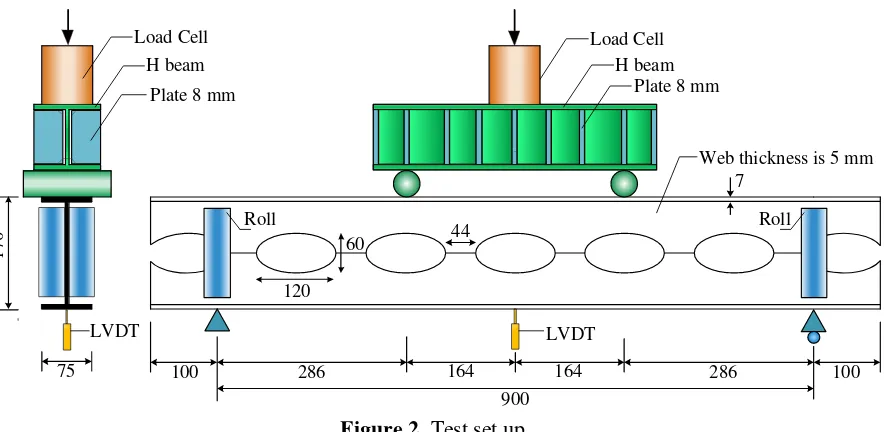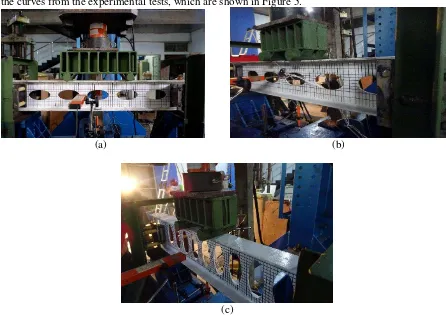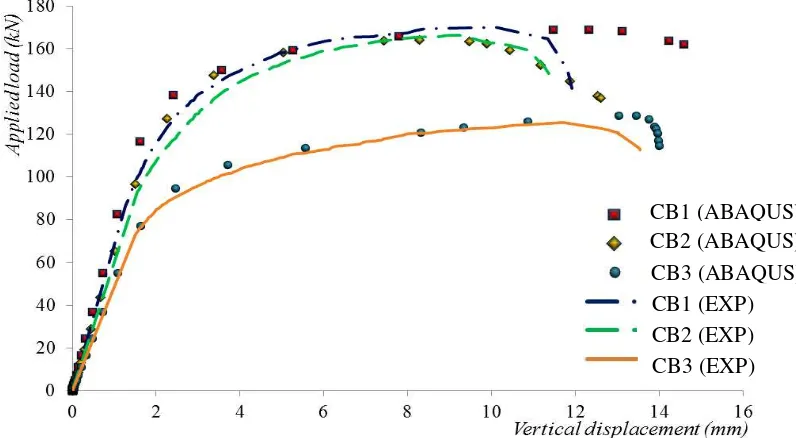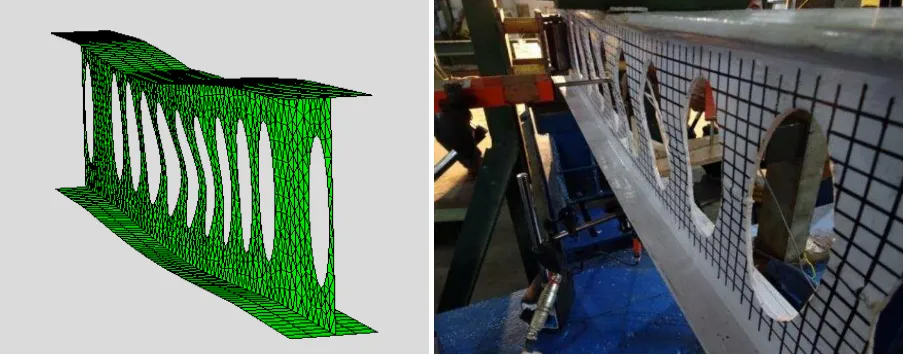Analysis of castellated steel beam with oval openings
S Tudjono1, Sunarto2 and A L Han1
1Department of Civil Engineering, Diponegoro University, Semarang-Indonesia 2Master program in Civil Engineering, Diponegoro University, Semarang-Indonesia
Corresponding author:[email protected]
Abstract. A castellated steel beam is per definition a wide flange (WF) or I shaped steel profile with openings, to reduce self-weight and improve the effectiveness in terms of material use. Recently, extensive study on these castellated steel beams has been conducted, involving different shapes in web openings. The main goal of these research works was to evaluate and analyze its optimum opening sizes and shapes configuration. More in-depth research work to the behavior and the influence of holes to WF beams need to be conducted. In this paper, an oval shaped web opening is chosen as alternate. The study involves a modification in the variation of oval web openings both in the horizontally and vertically direction. An experimental and numerical study based on the finite element method conducted with the Abaqus/CAE 6.12 software is used to analyze the buckling behavior of the web. The obtained results from the experimental test specimens are in good agreement with the obtained results from the finite element analysis. Furthermore, the numerical model can be expanded to be used as analyzing tool in evaluating and studying the effect and influencing factors of a variation in
opening’s parameters.
1. Introduction
A castellated steel beam is an I-shaped beam section with a variety in shape opening in the web. The opening can be hexagonal, rectangular, circular, diamond or oval in shape. The origin of the name “castellated” is derived from the pattern of holes in the web, because castellated means “built like a castle, or regular holes in the walls, like a castle”. The castellated steel beam is made by expanding a standard rolled shape in a manner which creates a regular pattern of holes in the web. At first, the chosen pattern is made along the web on a path that will be cut. The cut halve beams are separated and then welded together based on the chosen opening shape.
2. Review of previous studies
Extensive studies have been carried out in the field of design and analysis of castellated steel beams, starting from hexagonal until circular opening shapes. The aim of those studies was to explain the structural behavior of castellated steel beam with different opening shapes. The complexity in geometry and failure mode of castellated steel beams leads to a statement that there is no universally accepted design method for castellated steel beam. There are six possible failure modes for castellated steel beams, they are the formation of a Vierendeel mechanism, lateral torsional buckling of web post, rupture of a welded joint in a web post, lateral torsional buckling of an entire span, formation of a flexure mechanism, and the local buckling of web post [1].
A study concerning the horizontal shear strength of castellated steel beams with and without additional plates was conducted by Suharjanto [2]. In this study, the effects of the additional plate toward buckling are negligible. The result showed that maximum load on castellated steel beam with additional plate gave 26.16% higher values than without additional plates. It was concluded that additional plates on castellated steel beams resulted in a stronger section toward shear force and thus increased the load capacity and horizontal shear strength of circular castellated steel beam.
On the other hand, a research work about the vertical shear buckling capacity of web-posts in castellated steel beams with fillet corner for hexagonal web openings was investigated by Wang et al. [3]. This research was based on the finite element method. The authors compared the structural castellated steel beam performance of web post of fillet corner openings to circular and elongated circular openings. It was found that castellated steel beams with fillet corner opening have a better structural performance as compared to circular openings in terms of their failure mode, stress distribution, shear capacity, and out-of-plane displacement.
The recent study about the castellated steel beam with circular and diamond shaped openings was highlighted by Jamadar and Khumbar [4]. The aim of this research was to obtain the optimization of its size by considering the ratio of overall depth of the castellated steel beam to the depth of the opening, and the ratio of spacing between the opening to the depth of the opening. Results showed that the castellated steel beams with diamond shaped openings with an opening sized of 0.67 times the overall depth of the beam provided a better strength. It was also found that the castellated steel beams mostly tend to fail in their local failure modes.
3. Methodology
In this paper, the analysis was conducted experimentally, and numerically, using the finite element analysis. Finite element analysis is chosen due to the complexity of geometry of the castellated steel beam, and was executed with the Abaqus/CAE 6.12 software. Furthermore, the analysis result from the experimental tests were utilized to validate the model, analyzed by the Abaqus software.
In this research, an IWF 150 x 75 x 7 x 5 was chosen as original beam. The original beam was modified into a castellated steel beam with oval shaped openings, both in the vertical and horizontal direction. The modification can be shown in Figure 1 and the detail of test set up is seen in Figure 2.
170
150
286 164 164 286
The modification of castellated steel beams divided into three kind of specimens, they were CB1, CB2, and CB3. CB1 and CB2 are the modification of castellated steel beams with horizontal oval shaped web opening, having exact the same configurations but with a different loading position. This differentiation in loading position was used to study the effect of the position of the load. Meanwhile, the openings for CB3 are positioned vertically. When the developed FE model was proven accurate through a validation process, the model was further used as analyzing tool in evaluating and studying the effect of parameter-variations in the openings.
In the experimental test, the castellated steel beams were tested using a load cell with a capacity of 50 tons. As shown in Figure 2., the load was applied to the beam using a two-points loading system, four rolls for each castellated steel beam were located at the center of web, right above the supports, to prevent the ends from out-of-plane buckling and sections above the supports to rotate. To measure the displacement, one LVDT (Linear Variable Differential Transducer) SDP 100-C with a capacity of 100 mm, was used.
4. Finite element analysis of castellated steel beam with oval openings
The first step in the development of the finite element model was the construction of a model identical to the experimental specimens CB1, CB2, and CB3. The finite element model was an exact replica of the laboratory specimens in terms of their dimensions, openings, boundary conditions, and loading system. To simulate the physical supports, restrains in the direction of the degree of freedom were applied, as can be seen in Figure 3. A non linier material and geometry analysis together with isotropic material were chosen in this research work.
Figure 3. The model of castellated steel beam
From the obtained result of finite element analysis, it was shown that the horizontal loading position didn’t influence the load carrying capacity of the beam substantially. On the other hand, the modification of castellated steel beam with horizontal oval openings gave a higher value for the maximum load, as compared to the vertically one. In the finite element analysis, the maximum load and displacement of CB1 reached 169.17 kN with a vertical displacement of 12.32 mm, as for CB2 and CB3 the loads were 164.34 kN and 128.75 kN, and the displacements 8.29 mm and 13.03 mm respectively.
5. Experimental Validation
The results from the numeric solution should be validated to the experimental tests, so that the model can further be used as analyzing tool in evaluating modification of castellated steel beam with various opening shapes. The set-up for the castellated steel beams CB1, CB2 and CB3 are shown in Figure 4. Furthermore, the obtained load-displacement curves from the finite element analysis were validated to the curves from the experimental tests, which are shown in Figure 5.
(a) (b)
(c)
Figure 5. The experimental validation towards Abaqus
In the experimental test results, CB1 reached a maximum load of 170.17 kN in combination with the vertical displacement of 10.11 mm. CB2 reached the maximum load at 166.5 kN with a vertical displacement of 9.23 mm. Meanwhile for CB3, its maximum load was 125.584 kN and a vertical displacement of 11.71 mm. Based on the curves, it can be concluded that the horizontally modifications (CB1 and CB2) yielded in a better performance when compared to the section with vertically openings (CB3) in terms of load carrying capacity. It was also found that the different loading position on CB1 and CB2 had negligible effect on the load carrying capacity.
The results of the finite element model closely approach the experimental tests results. The differentiation between the load-displacement results from the model and the experimental specimens are shown in Table 1. The origin from these deviations are most probably due to the fact that in the finite element analysis the welding of the joints was neglected. In general, the results from the finite element model are in good agreement with the experimental results. Thus, the results can be compared to the original beam in terms of its maximum load. The visual comparison between the numerical and experimental castellated steel beams’ behavior in terms of deformation are shown in Figure 6, 7, and 8.
Table 1. The obtained results for the experimental test and Abaqus
Figure 6. Deformation condition of CB1 (left) Abaqus; (right) Experimental Test
Figure 7. Deformation condition of CB2 (left) Abaqus; (right) Experimental Test
Figure 8. Deformation condition of CB3 (left) FEM; (right) Experimental Test
be concluded that the results of finite element analysis provide an excellent representation to the behavior of castellated steel beams. Furthermore, the self-weight reduction of castellated steel beam towards the original beam can be analyzed by dividing the net web area of castellated steel beam with the web area of original beam. It was found the reduction ratio in self-weight for both horizontal and vertical modification toward the original beam were 0.92 and 0.90. Proven to be valid, the model can be used as analyzing tool in evaluating and studying the effect of a parameter variation in openings.
6. Conclusion
The castellated steel beam with horizontal oval shaped web openings resulted in a load ratio of 1.02 to the original beam. A small increase of 2.2% in load carrying capacity was recorded. The reduction ratio in self-weight was 0.92. Meanwhile, the castellated steel beam with vertical oval shaped web openings yielded in a strength capacity decrease, the ultimate load ratio to the control element was 0.78. The self-weight reduction ratio of this specimen was 0.90.
The member with the horizontal and vertical, oval shaped openings was substantially feasible, since no load-carrying capacity occur, but the self-weight of the member was optimized noticeably. Both of the horizontal and vertical modification almost gave the same weight reduction to the original beam, but the horizontal modification was satisfying better than the vertical one in terms of its load carrying capacity. Thus, it can be concluded that the horizontal modification gave a greater impact on its load carrying capacity rather than the vertical one. A lighter section has generally an encouraging impact on the overall construction cost, since a reduction in self-weight of beam members will, in turn positively influence the load acting on columns and foundation.
The results of finite element analysis using Abaqus are in a good agreement with the experimental results. The model was proven to provide a good estimation not only for the not load-displacement curves, but in predicting the failure mode of the element. Continuing research will be conducted using this basic model as analyzing tool in evaluating and studying the effect of a variation in opening’s parameters.
7. References
[1] Kerdal D and Nethercot D A 1984 Failure modes for castellated beams journal construction steel research J. Const. Steel Res. 4 pp 295-315
[2] Suharjanto 2011 Kajian kuat geser horisontal circular castellated steel beam with and without adding plates Jurnal Teknik Sipil 1 pp 65-71
[3] Wang P, Wang X and Ma N 2014 Vertical shear buckling capacity of web-posts in castellated steel beams with filler corner hexagonal web openings J. Engin. Struct. 75 pp 315-26




